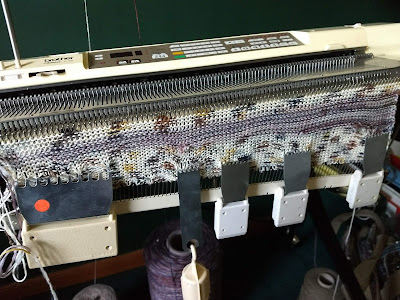
Have you noticed the proliferation of "waterfall" cardigans lately? Some are extremely exaggerated, and some merely seem to be a "mistake" (according to traditional dressmaking rules) of an exaggerated straight hem on an A-line garment. I myself have a Nic and Zoe sweater whose exaggerated extensions fall nearly to my ankles. There is a lot of extra fabric in it, on these side "wings". I actually like the overall length of this garment but think the extensions with exposed non-functional zippers are a little silly, if trendy. The zippers do add a nice diagonal line, which is always desirable for those of us in the "round" category.
After taking Susan Lazear's class on designing from an existing garment or from an illustration at Spring Fling, in Peru Indiana, I was inspired. She recommends using Garment Designer to copy the garment based on the garment measurements, or estimating the garment measurements by analyzing the proportions against your body type. For example, if an illustrated garment is fingertip-length, you can find the length measurement by finding another garment in your closet that is fingertip-length and measuring it.

For the last several weeks, I've been adding to the collection of pictures of garments that I think are
My Style on Pinterest. I noticed that the favorite garments in my closet are cardigans with shawl collars that have a lot of fabric on the front, enough to close the garment with a shawl pin or brooch if I want to, or to leave open. Some of these are "waterfall" cardigans, but some, like the Karen Scott one at the left, which I adore, are not. At least according to my definition of waterfall! Traditional cardigans without the shawl collar tend to fall open around my bust while wearing them, drawing attention to my extra curviness, and not being flattering.
So I was looking for, and collecting, garments that met that specification on many different plus-size websites. I came across many articles on style for over-50 and plus-size women, and I also found many different recipes for dressing different shapes. I am an "apple" shape, and I was pleased to find that several of them recommend my favorite garment shape for my body type.
Garment characteristics that are flattering to an Apple shape:
- V-neck
- Diagonal lines
- A-line
- Garment that skims the body, not hugging it
- Asymmetrical shapes
- 1/3 to 2/3 proportions or Golden Mean relationship to other pieces of the outfit or garment colors
One garment in particular was very exciting to me. The pattern is
Marcy Tilton's Vogue 9322. I may have been drawn to it by the lime-green color of the sample garment.
Aside: I had my colors done a few years ago, and was surprised to learn I am a "warm spring". All the blacks and reds and blues and greys in my existing work wardrobe were draining the energy from me, both visually and mentally! I've since drifted toward a brighter secondary color palette and notice that I have more energy.
Back to designing for knitting: The garment is a vest, with an extended collar. It has an A-line shape, and princess seaming. At first glance, the side pieces appeared to be made from one piece, front and back together in the pattern company flat drawing. However, upon zooming in and examining the lime green version photo, I can see a seam under the model's arm. This is better because it means smaller pieces to be knitted on the machine. This can be a problem for plus sizes. Just grading a pattern up, with certain yarns, may require more than 200 needles. It has pockets that extend beyond the hemline of the garment. Even though the original is a vest, I plan to knit it as a long-sleeved sweater.
The upper back is an inverted triangle ending at the waistline. This means the garment lines from the back resemble an "X", tricking the eye into seeing a classic hourglass shape. Unfortunately, the sizes are pattern-company sizes, not ready-to-wear sizes, meaning that the largest size is for bust 48 inches. So if I were to purchase the pattern, I would have to alter it anyway.
It will be a challenge to create the pattern pieces on Garment Designer. I've started, here is what I have so far.

Since Garment Designer expects you to knit the entire front of the garment as one piece, even if it is a princess style, I will need to figure out how to knit the pieces separately. It doesn't directly download to the knitting machine. I will need to work out how to separate the pattern pieces. This might involve printing a paper version of the pattern, cutting it apart, and then using the Knit Leader attachment for a KH-930. Or possibly transferring it into Design-A-Knit and knitting on the KH-970, although I have not explored the transfer method yet. Another alternative might be to transfer the graphics as a pixel-per-stitch graphic into AYAB and knit on the KH-910. The piece at the right is the "waterfall" back extension. Notice on the original how that extension forms a ruffle or slight peplum (or maybe a bustle?) at the back. I think the original is possibly rectangular, but I wanted a little less waterfall and a little longer coverage.
The collar may also need to be separated, because I may want to design it using a different stitch pattern so that there is interest on both the right and wrong sides of the fabric, since it is turned back.
I also need to think about the stitch pattern I will use for the garment and the finishing of the edges. My current pattern has bands for the front, hem and cuffs. There are so many possibilities for the edges, but because of the curves, many of them will be difficult.
I still need to verify the garment length, and work on the collar and curvature of the back seams. The length of the garment, when adjusted to my body size, does not seem as proportional as the flat drawings of the pattern on the Vogue web site.
I am thinking of printing the pattern out once I have completed my refinements, and making a "muslin" from commercial fabric before I invest time in knitting it. Marcy indicates that her pattern is suitable for either wovens or knits, and I have lots and lots of fabric in my stash. It wouldn't cost me anything except time! I never seem to have time for sewing any more!
But, before I start working on this again, I still need to prepare for the class this Saturday, cleaning up and packing up the machines I am taking, doing a final proofreading of the handouts, and printing them off.






































